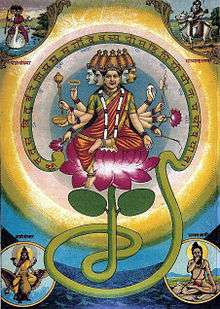Gayatri

Gayatri (Sanskrit: gāyatrī) is the feminine form of gāyatra, a Sanskrit word for a song or a hymn, having a Vedic meter of three padas, or lines, of eight syllables. In particular, it refers to the Gayatri Mantra and the Goddess Gāyatrī as that mantra personified.
Portrayal

Gayatri is typically portrayed as seated on a red lotus, signifying wealth. She appears in either of these forms:
- Having five heads (Mukta, Vidruma, Hema, Neela, Dhavala) with the ten eyes looking in eight directions plus the earth and sky, and ten arms holding all the weapons of Lord Shiva, Lord Vishnu and Lord Brahma.
- Accompanied by a white swan, holding a book to portray knowledge in one hand and a cure in the other, as the Goddess of education.
She is an aspect of Mata Saraswati, Mata Lakshmi and Mata Parvati, all three in one form, a form of Adi Shakti, as she is the human form of the Gayatri writings of the Vedas, hence called Gayatri meaning 'Gaya' to sing and 'tri' referring to the three Goddess, is the source of Brahma's power. Without her, Brahma remains dormant or unable to create. It's said that if one were to worship anyone, Gayatri, Lakshmi, Saraswati, Durga or Radha devi, it is equal to worshiping all the pancha (5) matha.
Gayatri is, in fact, the name applied to one of the most well known Vedic hymns consisting of twenty-four syllables. This hymn is addressed to god Surya (sun) as the supreme generative force. One translation of this hymn is: "We meditate on that glorious light of the divine Surya (Sun), may he, the lord of light, illuminate our minds". It is purported that repeating this hymn leads to salvation (moksha); that one who desires to attain heaven should recite it a thousand times each day; and that a person, who daily repeats the Gayatri hymn 3000 times for one month, shall be freed from guilt, however great.
Gayatri later came to be personified as a goddess. She is shown having five heads and is usually seated within a lotus. She is seen as a consort of Brahma.
According to the myth, one day Brahma was to perform his sacrifices to gods. But to do so it was important for Brahma to be married. h His consort's presence was indispensable to complete the ceremonies. Brahma asked the priest to fetch him any woman and wed him to her at the spot. Nearby was found a very lovely girl mostly seen near the Mt. Kailash Manasarovar region during that time . In reality, she was no other person than this Vedic hymn of Gayatri incarnated in the shape of that beautiful girl. Brahma immediately married that girl and kept her as his wife .
The five heads of Gayatri represent the four Vedas of ancient Aryans, and the remaining one represents the Almighty Lord himself. In her ten hands she holds all the symbols of Lord Vishnu including mace, lotus, axe, conch, sudarshan chakra, lotus, etc. One of the sacred texts explicitly reads, 'The Gayatri is Brahma, the Gayatri is Vishnu, the Gayatri is Shiva, the Gayatri is Vedas".
All sects of Hindus accept the importance of this hymn. Even the Arya Samajists, who do not believe in the worship of images and idols, proclaim this hymn as the most sacred one and in every prayer of theirs repeat the holy mantra to achieve success as well as salvation.
In popular culture
During the year 2003-04, a series based on Goddess Gayatri was aired on Doordarshan, the national TV channel of India on prime time (10 AM, Sunday). The serial also included the biography of Shriram Sharma, founder of the All World Gayatri Pariwar.
Notes
Further reading
- Sacinandana Swami: The Gayatri Book., Vasati Verlag, 2005, ISBN 978-3-937238-05-0
- "Gayatri Sahasranam", Swami Satyananda Saraswati, Devi Mandir (ISBN 1-877795-57-7)
- Sadguru Sant Keshavadas (2006) [1978]. Gayatri: The Highest Meditation. Dehli: Motilal Bandarsidass Publishers PVT. LTD. pp. 148 pages. ISBN 81-208-0697-2.
- Drake, Earl. 2015. Gayatri Rajapatni: The Woman Behind the Glory of Majapahit. Penang: Areca Books. ISBN 9789675719233
